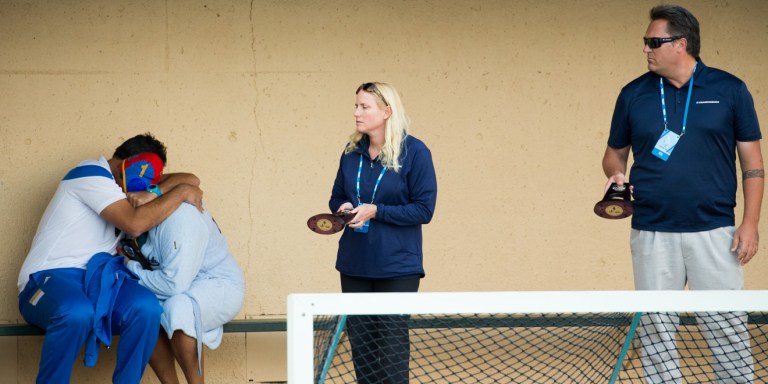“It is haunting for me to think about the players and how to go forward through this. You can talk a lot about the character that you get from sports and all the wonderful things you get from being a part of a team and all of that, but it is shameful for it to end like that.”
UCLA head coach Brandon Brooks fought back tears during Sunday’s post-match press conference as he reflected on his improperly called timeout that gave Stanford a penalty shot with 11 seconds left in regulation.
“For 99 percent of the game, it was what a championship should be,” Brooks said. “It was the two best teams in the country playing for the national championship. And as a fan, as a coach, as a player, that’s all you can ask for — to get there and get a shot at it.”
With 34 seconds remaining in the fourth quarter and the score knotted at six, Stanford came out of a timeout on a power play. Time ticked away as the Cardinal set up an attack, and with 15 seconds to go, junior Maggie Steffens let loose a shot that was saved by UCLA goalie Sami Hill.
Hill passed the ball out as the Bruins rushed back up the pool to their attacking end, and with 11 seconds on the clock, an air horn blew from the UCLA sideline signaling a timeout. The problem: Hill’s throw was to open water and the ball landed idly in the pool when the horn sounded.
Almost immediately, the officials ruled a penalty shot for Stanford, and after a two-and-a-half minute stoppage of play for a conferral, senior Kiley Neushul took the shot and netted the championship-winning goal.
The corresponding rule in the 2014-15 and 2015-16 NCAA rule book, number 12-6, states: “If a team calls for a timeout when neither team has possession of the ball, the referee shall blow the whistle and award a penalty throw to the team that did not call the timeout, and take away the longest timeout available from the team that called the timeout improperly.”
While after a heartstopping 31 minutes and 49 seconds of play, it might have been more fitting for the championship to not have been decided on a penalty shot and a seemingly obscure regulation, the officials did make the right call (see timestamp 1:09:51 in the video below).
“It’s the rule. You can’t call timeout when you don’t have possession,” said Stanford head coach John Tanner. “There’s a scramble when we have a shot, and we even talked about it in our timeout — because they had a timeout, we would chase rebounds, and that’s what we did. So they had to throw the ball out.
“So without clear possession, that is the rule. It’s unfortunate, but as I said, we had fight throughout that fourth quarter.”
The more interesting point, however, is that Rule 12-6 was modified for the current NCAA rule book used for both this past season and the 2015-16 season. A new rule book is published every two years, and back at the Water Polo Rules Subcommittee’s annual meeting in February 2014, it decided to amend what had previously been the regulation.
In the regulations for the 2012-13 and 2013-14 seasons, the punishment for a timeout called without possession of the ball was solely that the ball would be awarded to the team that did not call the timeout. The rule then stated, “A penalty throw is awarded to the opposing team if the team that improperly called timeout had no timeouts to take.”
However, the Rules Subcommittee axed that final addendum at their meeting, and replaced the words “award the ball” to “award a penalty throw.”
In a memo dated September 5, 2014 sent from Brian Streeter, the secretary-rules editor of NCAA Men’s and Women’s Water Polo Rules Subcommittee, to all men’s and women’s water polo head coaches, the rule was clarified further.
The memo stated: “Possession includes physically controlling the ball, holding the ball, or the referee’s whistle indicating one team has been awarded the ball. Possession does not include when the ball is in the air on a pass or shot, nor does it include being closest to or merely touching the ball without physically controlling or holding the ball.”
Thus, upon further review, the ruling on the pool stands.
Contact Jordan Wallach at jwallach ‘at’ stanford.edu.
